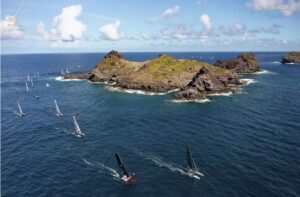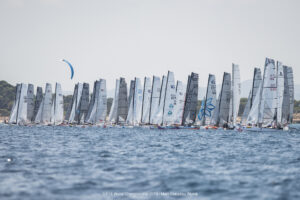By Olivier BOVYN, President of the International Formula 18 Class Association
For many years, and with the exception of the “A” and Tornado Classes, sport catamaran sailing has been linked to manufacturer classes. From club level to the largest events, racing on corrected time was the only way to allow different designs to compete, with sometimes endless discussions about the timetable or yardsticks used to do so.
Off this reason, we started to work, through the catamaran section created in 1985 by the French Sailing Federation, on a rating system based on a set of IOMR formulas, further to the Pacific Multihull Association system. With the support of various European National Authorities, this job lead in 1992 to the implementation of the SCHRS, Small Catamaran Handicap Rating System, which is since under the umbrella of ISAF.
A clear need for racing on elapsed time appeared with the first long distance race sailed in China Sea, organised by Gérard d’Aboville (the man who crossed over the Ocean by rowing). It was then agreed with Pierre-Charles BARRAUD, FFV Technical Officer, to fix one single rating for the whole fleet, with some success.
Following this very first event, a CataWorld Cup circuit was created, using the ICCA measurement regulations written by Yves LODAY and some other competitors, but these rules lead to a majority of expensive “One off” boats, hindering any further large development.
In order to broaden the access to elapsed time racing to a maximum of catamaran sailors, Pierre-Charles BARRAUD and myself, as the executive of the FFV Catamaran Section, decided then to create in 1994 the Formula 18 using the SCHRS formulas to compute the performance parameters. The aim was the following :
- to provide fair racing for crews of various weights, from 115 to over 150 kgs, through the use of two different sail sizes of jibs and spinnakers, linked to the use of limited corrector weights;
- to maintain competition between the manufacturers in order to keep the costs at the lowest level;
- to allow mixed or female crews to compete on an equal basis in large male fleets;
- to protect the interests of the club sailors through an actual measurement procedure.
This concept was probably a good one, as the class grew up so quickly that the ISAF Recognised Status was granted in 1996, eighteen months after the birth of the formula. Mainly European at the beginning, the Formula 18 is now spreading to Australia, New Zealand and North America, with not less than twelve different designs affordable on the market at the moment.
To conclude, Formula 18 sailing offers probably the best balance between cost and value, fairness and competition, to the wider range of crew statures.
Last but not least, the Class is extremely proud to welcome numerous Olympic sailors to the annual World Championship, as it is a clear assessment of the Formula 18 skill level.
All what you have ever expected in catamaran sailing will probably given to you by Formula 18. Numerous National Associations and sailing clubs are ready to welcome you, and I will be for sure very happy to meet you in some venue in the near future, if you decide to join our family.
Wishing you all the best, sincerely,
Olivier BOVYN
